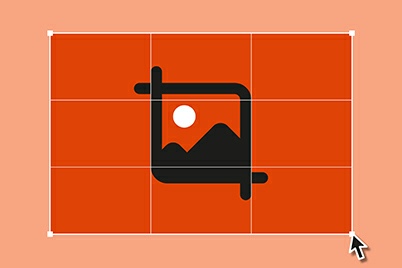

07584-


CREAM OF THE CROP
Photography -
Images are an essential part of our daily lives. With digital photography and smart phones becoming ever more sophisticated, the ease in which images can be captured is now more apparent than ever. Images are a great way of communicating, whether it be capturing a specific moment, showing how something works, helping to explain an event or just adding interest to grab a viewer’s attention. However, capturing the ideal image in the instant that it needs to be taken is almost impossible and this is where image cropping is so important.
These days most cameras and smart phones have built-
Image cropping is almost as important as the crop itself. The crop tool is an invisible frame that draws the eye of the viewer to the most important parts of the image. Making the correct crop can have a dramatic impact on your images and even allow you to emotionally engage with your audience. The following article will give you tips on how to crop your images to show them off at their very best.
a. The Rule of Thirds
The rule of thirds divides an image into three equal horizontal sections and three equal vertical sections. This results in nine individual boxes, the concept being that you want to place the points of interest in your image near to where these lines intersect. Try to avoid your subject being placed in the centre of the image. By using the rule of thirds and keeping your subject to either the left or right of the cropped image can help create a more interesting photo. Most cameras and smart phones will show this grid on the display, either when taking the photo or using the crop tool.
b. Tell a Story
Be careful how you crop a picture as removing key elements may change the story or the message that you are trying to portray.
c. Remove Unnecessary Details
The opposite of point ‘b’ above is that it is equally important to delete any parts of your image that will distract from the story or message that you are trying to portray. It is important to pay close attention to the edges of the image, eyes (if relevant) and text (if relevant) as these are the areas that the viewers eyes will be drawn to. If these parts of the photograph are not relevant, remove them if possible, during the cropping procedure.
d. Leave Sufficient Room Around Faces
When cropping a facial image, it is important to leave a sufficient area around the face, known as ‘look space’ so that the subject is more relaxed and pleasing to the eye than if the face appeared from edge to edge.
e. Avoid Cropping Limbs at the Joint
Try to avoid cropping your subjects’ limbs at the joint, such as the arms, hands, fingers and ears. By doing this it can make for an awkward image, so it is best to crop a person at the torso, waist, shin or upper arm.
f. Don’t Crop Too Close to the Hairline
Always remember when cropping a person’s face, not to go in too close to the hairline as you can unintentionally make them look bald in appearance. If you leave enough hair in the shot, the viewers imagination will fill in the rest.
g. Always Leave the Horizon
When cropping landscape images, it is important to leave in the horizon line to give a depth of scale. Use the Rule of Thirds and keep the sky at one third of the total image and the land at two thirds to give a focal point to the land area of the photo.
h. Crop in Close for Drama
By cropping in close you can focus in on the emotion, eye contact (if a person) and the intimacy of the subject which can help attract the viewers attention to the area of the image that has the largest dramatic effect.
The above tips can all help create a dramatic and focused image from your original photograph. Where possible, always remember to save your cropped images as a different file from the original. That way, you can always go back to your initial shot, should you require a different crop to achieve the final image you require.
Please note that the views, thoughts, and opinions expressed in this article belong solely to the author, and not necessarily to any other group or individual. To ensure you are fully compliant with all current legislation, please take legal/professional advice and do not rely solely on the information provided in these articles.

Copyright © 2018-
Terms of Use | Privacy Policy, GDPR & Cookie Policy | Trading Terms





